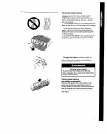
For Best Results
Hot water is a must
Hot water dissolves and activates the dishwashing
detergent. Hot water dissolves grease on dishes
and helps dry glasses spot-free. Make certain
loads are washed in hot water. Two ways to have
a reliable hot water supply..
1.
2.
Maintain a 140°F (SOOC) water supply at central
water heater. To check water temperature, turn
on hot water
faucet
nearest the dishwasher. Let
water run until it is as hot as possible, then
check wrth a candy or meat thermometer. If the
temperature at the faucet is below 135°F
(57”C), have a qualified person raise the water
heater thermostat setting.
Use the Hi-Temp Option. If water heating is
needed, a thermostat will delay the cycle while
the dishwasher heats the water until the tem-
perature reaches 140°F (SOC). If water is hot
enough, the cycle will proceed with no delay.
This lets you turn down your water heater, if
you
choose, without cutting back on hot water
needed for good dishwashing.
Quiet operating tips
To avoid thumping and claftenng noises during
operation:
l
Make sure lightwelght load Items are secured in
the rack.
l
Make sure pot lids and handles, pizza pans,
cookie sheets, etc. do not touch intenor walls or
interfere wrth either of the spray arms rotatron.
l
Load dishes so they don’t touch one another.
NOTE: Keep sink drain plugs inserted during
dishwasher operation to prevent noise transfer
through drains.
Special tips
Remember, use your dishwasher only for the
job it was designed to do. Some items are not
drshwasher safe or ma’y require special care.
Read these special tips for the following items:
Aluminum: Alummum loses its bright, shiny
appearance and darkens In color due to minerals
In the water and the alkalinity of the dishwasher
detergent. Colored aluminum may fade.
TIPS: If washed in the dishwasher avoid
placing directly In front of detergent dispenser
where it could be sprinkled with undissolved
detergent, causing spotting, pitting, and
discoloration. Follow utensil manufacturer’s
cleaning instructions.
China: Check manufacturer’s recommendations.
Hand-painted, metal-trimmed, and antique china
fade due to high water temperatures and alkaline
detergent solution in the dishwasher,
NOTE: Delicate, antique items should not be
washed in the dishwasher.
TIPS: Load china carefully. Do not allow
pieces to touch each other. Test one piece by
washing it daily in the dishwasher for several
weeks. Then compare it with the rest of the
set to see if colors have changed.
Crystal and decorative glasses: Crystal can
break from sudden exposure to high water temper.
ature. Metal trim and colorful decoration on glass
wtll fade in time when washed in the dishwasher,
NOTE: Delicate, antique items should not be
washed in the dishwasher.
TIPS: Load crystal carefully in top rack
only. Se sure to load a few larger items in the
bottom rack to reduce amount of force of
water spray reaching glassware from lower
sprayarm. Use the shortest cycle.
Flatware: Salty and acidic food may tarnish
silver and stainless flatware if allowed lo remain
on the utensils. A film may form on sterling silver
and silver plate items washed in a dishwasher.
This film is caused by reaction of silver with
chlorine in the detergent. Gold flatware is not
dishwasher safe. The adhesive used in some
flatware with hollow handles is not heat resistant.
causing the handles to come off In the dishwasher.
Wash by hand.
TIPS: Rinse flatware as soon as possible.
especially If it
IS
not to be washed right away.
Dishwasher detergent may remove antrque
finishes. Wash by hand. Tarnish and film
build-up can be removed with silver polish.
Cast iron utensils: The seasoned finish will be
removed in Ihe dishwasher. Ruslrng will result.
TIPS: Wash by hand. To re-season. coat with
unsalted fat and heat in a slow oven for an
hour or two.
Plastics: Many plastics will have “Dishwasher
Safe” written on them. Some plastics are heat
sensitive and may melt or warp.
TIPS: If in doubt, try one piece. Place in
upper rack only. Air Dry Option provides
additional protection.
Non-stick finish utensils: Most can be washed
in the dishwasher,
TIPS: Follow manufacturer’s suggestions.
Wood: Many wooden items will crack and warp or
lose their finish.
TIPS: Do not wash cutting boards, wooden
salad bowls or knives with wooden handles in
the dishwasher.
Pewter or pewter-like materials: Items may
streak, discolor, and pit
TIPS: To keep pewter at Its very best, hand
wash with mild detergent.
16


















